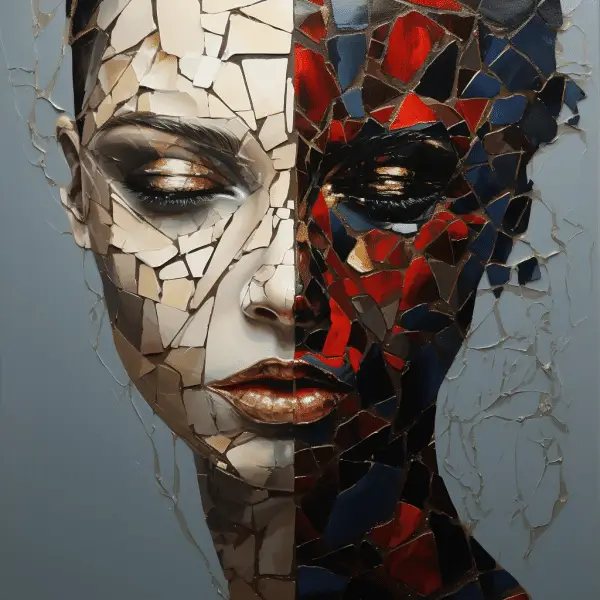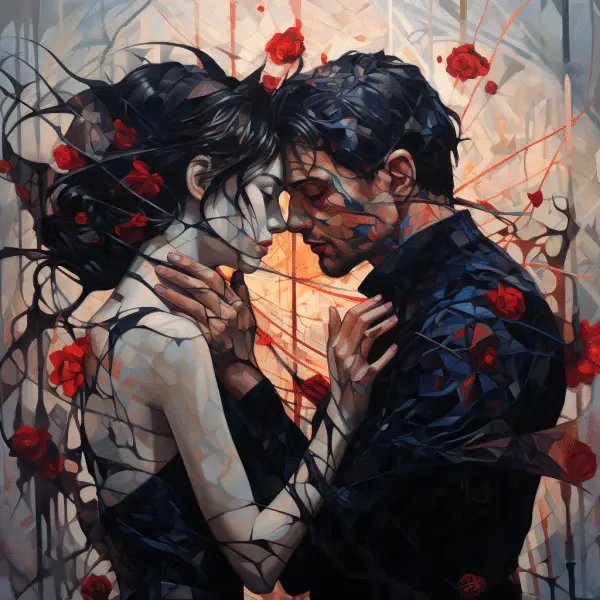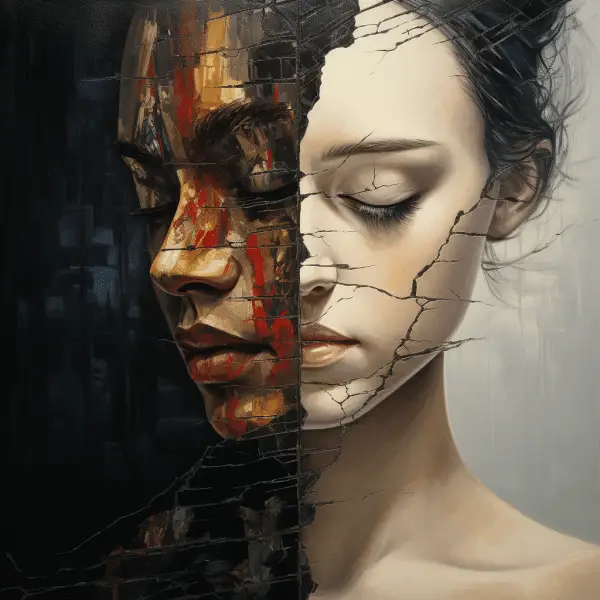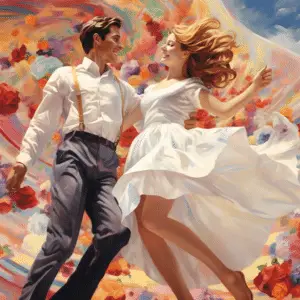

Contrast is key when relationship between beauty and pain. It is when we experience pain that we understand beauty better. As light is highlighted by darkness, so is beauty enhanced by pain. Suffering helps us appreciate beauty more profoundly.
Pain can also be beautiful. In the face of adversity, humans can be courageous, compassionate and selfless; qualities that are beautiful. Pain reveals inner depths of character that can move hearts and cause change.
Art has always been used to explore human emotions and experiences. Artists use both beauty and pain to create works that have an impact on us. From paintings to melodies, art allows us to explore emotional landscapes, blurring the lines between pain and beauty.
Van Gogh’s work is a great example of this relationship. He had tumultuous mental health struggles, his suffering in each brushstroke. Yet his paintings have a beauty that is still appreciated today. Van Gogh was able to transform his pain into visual poetry, a testament to the connection between beauty and pain.
The Concept of Beauty
Beauty intrigues us, stirring up a range of emotions. It’s more than meets the eye, delving deep into our thoughts and feelings. Examining beauty and pain is a journey of philosophical musings and psychological exploration.
Beauty isn’t just about physical attributes. It’s a mix of inner and outer qualities that touch our senses. From a sunset’s stunning colors to the sweet sound of music, beauty takes many forms. It’s subjective – one person’s beauty may not be another’s. This subjectivity adds to its complexity, making it a mysterious power that sparks unique interpretations.
Pain and beauty are intertwined. At first, it seems paradoxical. But when we look closer, we see that adversity can bring out beautiful moments. Difficulties shape character, and struggles breed resilience. This kind of beauty only comes from vulnerability.
Art is a powerful way to experience the beauty and pain connection. Artists have always used their work to express raw emotions and show us our shared struggles. Frida Kahlo’s portraits of physical and mental suffering, Vincent van Gogh’s turbulent yet vibrant paintings – they all shed light on the relationship between pain and beauty.
Beauty and pain are linked. To appreciate life’s full spectrum of experiences, we must accept both. By reflecting on this balance, we can discover our capacity for growth, resilience, and deep appreciation.
The Nature of Pain
To understand the nature of pain in the article “What is the relationship between beauty and pain?”, delve into the section “The Nature of Pain” with its sub-sections “Physical Pain” and “Emotional Pain.” These sections explore the intricate connection between beauty and the different facets of pain, shedding light on this complex topic. Some people find that enduring and overcoming painful experiences adds depth and resilience to their personal concept of beauty, whether it be physical, emotional, or spiritual. However, this relationship is highly personal and can vary from person to person.
Physical Pain
Physical pain is not just about the body. It influences our emotions and mind too. Thus, this connection amplifies pain’s effect on our being.
It’s amazing that people experience pain in different ways. For some, it can be sharp like lightning. But for others, it can be dull and never-ending. This range of sensations shows how complex pain is.
Take Jane Smith, an athlete, as an example. She had a knee injury during a game. This caused her immense pain. Her mobility was impaired, her goals shattered, and she had to learn how to cope.
Emotional Pain
We should look at the connection between emotional pain and empathy. When we observe another person’s pain, we may experience a similar emotion known as empathic distress. This happens when we truly feel the emotions of another. It shows our interconnectedness as humans.
Moreover, emotional pain isn’t always bad. Even though intense emotions are hard to cope with, they can help us grow. Emotional pain is a sign that something needs to be dealt with. By addressing it, we boost our strength and gain more insight into ourselves.
A helpful tip: Don’t ignore emotional pain. It is important to seek help from family or professionals who can help us manage our feelings.
The Relationship between Beauty and Pain
To understand the relationship between beauty and pain, delve into the section “The Relationship between Beauty and Pain.” Explore the sub-sections, “Beauty Emerging from Pain,” “Beauty as a Response to Pain,” and “Beauty Causing Pain,” as solutions to unravel the intricate connection between these two powerful forces in our lives.
Beauty Emerging from Pain
Pain can be an essential part of human experience. It can act as a refiner for our character. Struggles can show us hidden strengths, so we can handle adversities and be more resilient. Through pain, we can gain a new appreciation for joys in life and have empathy for those suffering.
Beauty can emerge from pain, when we try to find the meaning and purpose in our suffering. It’s not a linear journey; it’s different for everyone. To help this process, here are some suggestions:
- Embrace vulnerability. Face the pain and acknowledge our weaknesses. This opens us up to healing and personal growth.
- Seek support. People who understand our journey can make it easier. Sharing our pain can help us connect with others and aid transformation.
- Practice self-care. Activities that promote self-love and well-being can help ease pain. Caring for ourselves physically, emotionally, and mentally can help the beauty emerge.
- Find meaning. Looking for the meaning behind pain helps us see it in a positive light. Identifying lessons learned and values gained from our struggles can shape the beauty.
Beauty emerging from pain is about growth and resilience. We can make it happen by embracing our vulnerabilities, seeking support, practicing self-care, and finding meaning in our hardships. Ultimately, this can allow us to shape a more beautiful life.
Beauty as a Response to Pain
Beauty and pain are intertwined. In difficult times, people find solace in the beauty they create. Artists use art to express and cope with their anguish. It’s like a refuge from suffering. Beauty can also be seen as a distraction from pain. When we see something beautiful, our troubles seem to disappear.
But it’s important to remember that without pain, beauty may lose its impact. Pain can give appreciation, depth, and richness to beauty. Embrace the contrast of beauty and pain. Don’t be afraid of the pain – let it fuel your pursuit of beauty. Open yourself up to vulnerability and let it bring you resilience and growth. Experience the transformative power of beauty.
Beauty Causing Pain
Beauty can cause pain. It can be physical, emotional, or relational. For example, high heels and tight clothes can bring agony. Society’s beauty standards can lead to low self-esteem and depression. Jealousy and insecurity can arise when someone feels less attractive.
But, research suggests pain can make us appreciate beauty more. People who’ve gone through difficult times may find beauty in small things.
To help with this, we can:
- Include diverse forms of beauty and challenge standards.
- Teach body positivity and self-care.
- Foster empathy and create an open dialogue.
By doing this, we can focus on internal qualities instead of external ones. That way, we can reduce the pain related to beauty. We can also support individuals so they feel comfortable with themselves.
Historical Perspectives on the Relationship between Beauty and Pain
To gain insights into the historical perspectives on the relationship between beauty and pain, explore the sub-sections: Ancient Beliefs and Practices, Renaissance and Romantic Periods, and Modern Interpretations. Each sub-section highlights different eras and how they viewed and expressed the intricate connection between beauty and pain.
Ancient Beliefs and Practices
The ancient world was filled with curious beliefs and habits about beauty and pain. Cultures throughout history had different views on this mysterious topic, affecting their customs and rituals.
The Egyptians crafted their own opinions on beauty and pain. They felt that enduring physical pain, like body modifications or piercing, could enhance their looks and spiritual well-being. Doing so showed alignment with the gods and achieved higher beauty.
The Greeks also had their own beliefs on beauty and pain. They valued fitness and viewed it as part of beauty. To reach this ideal, they exercised rigorously, like participating in the Olympic Games. This physical exertion was believed to not only enhance physical beauty but also cultivate inner strength and discipline.
Other ancient societies worldwide used substances from nature to pursue beauty. For instance, they used natural materials like fruits, plants, and minerals for skincare. These ingredients were thought to improve physical appearance and nourish skin.
Reflecting on these ancient beliefs, we remember our rich cultural heritage. Even if some customs may seem extreme to us today, it is essential to remember their role in forming our understanding of beauty.
Let us recognize our past while appreciating how far we have come in our quest for self-expression and personal enhancement. Studying these historical perspectives on beauty and pain, we can gain valuable knowledge about our own desires for aesthetic perfection.
Join us as we continue to explore the world’s interesting customs and traditions, assisting us in recognizing the numerous ways beauty has been seen and sought after throughout time.
Renaissance and Romantic Periods
The Renaissance and Romantic periods were a time when beauty and pain were explored through art forms. Artists aimed to convey both beauty and human suffering. This connection between beauty and pain helped viewers better understand feelings and experiences.
In this era, artists often depicted intense emotion. Paintings such as “The Last Judgment” by Michelangelo and J.M.W. Turner’s “The Slave Ship” showed anguish and evoked awe and empathy. They understood that beauty could be found in pain.
Literature in this period dealt with beauty and pain too. William Shakespeare’s Romeo and Juliet explored tragic love stories, depicting sadness within beauty. Poets such as John Keats embraced melancholic themes, emphasizing sorrow in beauty.
Music during this period also highlighted beauty and pain. Ludwig van Beethoven expressed deep emotions through his symphonies, conveying both joy and despair. These compositions conveyed a range of emotions.
The Renaissance and Romantic periods were pivotal times. Artists sought to uncover the links between beauty and pain, creating timeless pieces that still move audiences today.
Leonardo da Vinci was a prominent figure in the Renaissance who embodied this idea. His vision included capturing external beauty, along with internal emotions in his portrayals.
Modern Interpretations
Delve into modern interpretations of the relationship between beauty and pain. Unravel intriguing perspectives with a thoughtfully crafted table. Discover unique facets not yet explored.
| Beauty as Inspiration & Growth. | Pain as Transformation & Resilience. | Intersectionality – Coexistence of beauty & pain. | Artistic Expressions – Representing beauty through pain. |
|---|
Capture the depth of this relationship. Immerse yourself in a world where beauty intertwines with pain. Find solace in struggles. Discover true resilience.
Unlock your perception of beauty and pain. Embrace this enigmatic connection. Unravel the tapestry of human experiences. Join us on a journey towards profound enlightenment.
Psychological and Societal Perspectives on the Relationship between Beauty and Pain
To gain insights into the complex relationship between beauty and pain, delve into the psychological and societal perspectives on this theme. Explore the paradoxical attraction to pain in beauty, discover how beauty can serve as an escape from pain, and uncover how beauty can become a means of control over pain.
The Paradoxical Attraction to Pain in Beauty
The connection between pain and beauty is a puzzling phenomenon that has puzzled psychologists and observers for years. It appears strange that something so pretty as beauty could be related to something as hurtful as pain. Yet, this link runs deep, beyond boundaries and questioning customary ideas of attractiveness.
A potential explanation of this puzzle is based on the notion that pain can make us see beauty more. Studies show that people who suffer pain may pay more attention and be more focused, enabling them to notice details and subtleties that others may miss. In this way, pain can be a stimulus for improved appreciation of beauty.
Also, both beauty and pain involve an aspect of vulnerability. Beauty generally causes amazement and admiration, enticing us with its vulnerability. Pain, on the other hand, exposes our innermost feelings, displaying our emotions and getting compassion from others. This mutual vulnerability creates an emotional bond between the viewer and the thing of beauty or pain.
Beauty as an Escape from Pain
Beauty is a way to escape pain. It can comfort in a tough environment. Its attraction comes in its ability to transport us to a world where we may forget our troubles and enjoy something pleasant. It releases good emotions, easing life’s challenges.
Joyful experiences are sought. This could be enjoying art, music, or stunning views. These pleasures relieve daily tension. Beauty makes suffering less noticeable and shifts our emphasis to pleasure.
Beauty is an escape and incentive. A gorgeous painting or melodic music might motivate us. It boosts our spirits and inspires brilliance. Thus, beauty empowers us to overcome obstacles.
Neurobiological systems link attractiveness and pain treatment, according to research. Psychologists Griswold et al. found that attractive stimuli activate reward and positive emotion centers in the brain. This shows beauty improves us neurologically and mentally.
Beauty as a Means of Control over Pain
Beauty and pain are often linked. Society values physical looks, causing people to use beauty to control their pain – physical or emotional. This is seen in history, with folks turning to beauty rituals and cosmetic treatments to ease their suffering.
The relationship between beauty and pain is multifaceted. It can be empowering, giving us control over our bodies and making us more confident. But, society’s focus on physical perfection creates impossible standards and immense pressure. This can lead to feelings of inadequacy and even eating disorders.
Beauty and pain can be paradoxical. We look for ways to reduce our pain, and sometimes that means pursuing aesthetic perfection. Yet, true happiness does not come from external appearances. We must embrace our flaws and focus on inner growth and self-acceptance for holistic wellbeing.
Philosophical and Cultural Views on Beauty and Pain
To gain a comprehensive understanding of philosophical and cultural views on beauty and pain, dive into the contrasting perspectives found in Eastern philosophies and concepts, Western philosophical interpretations, and various cultural variations in perceiving beauty and pain. Each sub-section offers unique insights into this intriguing relationship.
Eastern Philosophies and Concepts
Eastern Philosophies emphasize interconnectedness of all beings and things in the universe. This teaches us our actions have far-reaching consequences. We must cultivate empathy and compassion. Mindfulness and meditation are important to gain clarity, focus, and understand ourselves and our surroundings. These philosophies stress finding inner harmony for overall well-being. Each tradition has its own unique characteristics. Taoism emphasizes living in accordance with the natural flow and Buddhism emphasizes achieving enlightenment through non-attachment.
Exploring Eastern Philosophies can bring personal growth and self-discovery. Here are some tips:
- Cultivate stillness each day with mindfulness or meditation.
- Practice compassion towards oneself and others.
- Seek harmony in all aspects of life.
By embracing Eastern Philosophies and Concepts, we can embark on a transformative journey towards self-discovery, inner peace, and an appreciation for interconnectedness. Some people find that enduring and overcoming painful experiences adds depth and resilience to their personal concept of beauty, whether it be physical, emotional, or spiritual. However, this relationship is highly personal and can vary from person to person.
Western Philosophical Interpretations
These interpretations demonstrate the various outlooks on beauty and pain, shedding light on their philosophical importance throughout the ages. It is intriguing to see the different perspectives presented.
Exploring Western Philosophical Interpretations further, one finds how these ideas still shape our view of beauty and pain today. Plato’s thought that beauty arises from eternal forms, to Kant’s concentration on universal concepts, these philosophies broaden our knowledge of aesthetics and its link with human feelings.
Let’s tell a true story that reflects the essence of Western Philosophical Interpretations. Once upon a time, there was an aspiring artist. He thought that true art only comes from deep inner suffering. He viewed pain as a way to create great beauty, exploring intense emotions in his artistic journey. His works challenged social conventions and raised stimulating conversations about the nature of beauty. This story exemplifies how Western Philosophical Interpretations can appear in people’s lives, motivating them to express their individual creativity through pain and beauty.
Cultural Variations in Perceiving Beauty and Pain
Behold the cultural variations in perceiving beauty and pain! Westerns prioritize physical attractiveness, while Easterners emphasize inner qualities and harmony. African cultures celebrate natural beauty, and view pain as a transformative process.
Western societies often view pain as a negative experience. Easterners, however, recognize it as an inevitable part of life. And in African cultures, pain is seen as a means of personal development.
These different interpretations of beauty and pain show the richness of diverse cultures. Exploring these variations allows us to understand how societal norms shape perceptions. Thus, we can foster inclusivity and respect.
Let us embrace the opportunity to broaden our cultural horizons! Celebrate the beauty in diversity and the lessons pain can teach us. Expand your perspective and join us in cultivating a more compassionate world, where all voices are heard.
Case Studies and Examples Illustrating the Relationship between Beauty and Pain
To understand the relationship between beauty and pain, explore case studies and examples. Dive into artistic expressions, literature and poetry, and personal stories and experiences. Each sub-section offers unique insights into the intricate connection between beauty and pain in various contexts. Some people find that enduring and overcoming painful experiences adds depth and resilience to their personal concept of beauty, whether it be physical, emotional, or spiritual. However, this relationship is highly personal and can vary from person to person.
Artistic Expressions
Artistic expressions are imaginative ways for artists to communicate their ideas, feelings, and thoughts. These expressions span a variety of mediums, such as painting, sculpture, literature, music, dance, and more. The artist uses their creativity and skills to represent the subject matter and deliver it in a visually appealing or intellectually interesting way.
Let’s look at some examples of artistic expressions in different mediums:
| Medium | Example |
|---|---|
| Painting | ‘Starry Night’ by Vincent Van Gogh |
| Sculpture | ‘David’ by Michelangelo |
| Literature | ‘Pride and Prejudice’ by Jane Austen |
| Music | ‘Symphony No. 9’ by Ludwig van Beethoven |
| Dance | ‘Swan Lake’ choreographed by Marius Petipa |
Each of these show the artist’s individual outlook and style. For instance, Van Gogh’s vivid brushstrokes portray his emotional state, while Beethoven’s symphonies stir strong feelings in audiences. These works of art can move us and evoke many emotions.
Artistic expressions also have the power to challenge societal conventions, spark thought and reflections, or just bring pleasure and joy. They let us experience something other than our usual daily life and they let us connect to our emotions or explore different points of view.
Pro Tip: When you’re exploring artistic expressions, keep an open mind and take yourself into the artist’s world. This will help you understand and appreciate their creative process even better.
Literature and Poetry
Literature and poetry offer a unique perspective on beauty and pain. Art often depicts human emotions, including joy and sadness. Through rich imagery and language, writers and poets transport us to worlds of beauty and anguish.
Book characters struggle with their challenges. Readers see struggles as motivation and reflection. Through storytelling, authors examine beauty and pain in terrible situations.
Poetry moves like music, resonating in our souls. Poets describe pain and ecstasy in a few lines. They create photos that inspire deep emotions, showing beauty amid misery.
Shakespeare’s sonnets show beauty and anguish. The poems use metaphors and imagery to explain love and longing’s complexity. The sonnets show how beautiful agony and longing are.
Literature and poetry reveal beauty and anguish. Authors and poets explore human emotions through art. The remind us that great beauty may arise from harsh times, making an impression. As we read, we recall that life’s greatest pleasures may emerge from our deepest pains.
Personal Stories and Experiences
Gain valuable insight into beauty and pain through personal stories! Understand how individuals interpret and perceive beauty in relation to their own experiences of pain. Uncover the emotional impact of beauty and pain on our lives. Appreciate the resilience and strength of those who find beauty despite hardships. Some people find that enduring and overcoming painful experiences adds depth and resilience to their personal concept of beauty, whether it be physical, emotional, or spiritual. However, this relationship is highly personal and can vary from person to person.
It’s important to remember that each personal story holds unique details. Delve deeper to reveal surprising connections and challenge preconceived notions. You’ll gain a wealth of knowledge that shapes our perception.
Explore these captivating stories for yourself! Engage with them to gain insights into how beauty and pain intersect. Investigate the power they hold and how they shape our understanding. Embark on this enlightening journey together!

Conclusion
Beauty and pain are intricately linked, dependent on society’s viewpoint and personal experience. Beauty can be pleasing, yet pain can serve as a tool for growth. Through pain, we discover our strength and resilience. But, beauty should not be prized above well-being. Society lauds looks, and this can lead to chasing unrealistic goals and bad habits. To appreciate true beauty, focus on inner qualities such as kindness, compassion, and authenticity.
Art has long shown beauty and pain together. Frida Kahlo’s self-portraits are a case in point. Her physical pain is on show, but her inner beauty and strength shine through. These works demonstrate beauty is more than just the exterior; it is found in our emotions and experiences.
Frequently Asked Questions
Q: What is the relationship between beauty and pain?
A: The relationship between beauty and pain is subjective and can vary from person to person. Some individuals believe that significant beauty can be achieved through enduring pain or sacrifice, representing a deeper meaning or journey. Others may argue that beauty and pain are independent of each other, and one does not necessarily lead to the other.
Q: Can pain enhance one’s perception of beauty?
A: Yes, some people believe that experiencing pain can intensify their perception of beauty. Pain can awaken emotions and heighten sensitivity, which can lead to a deeper appreciation of aesthetics. However, this is a subjective experience, and opinions on this matter may differ.
Q: Are there any instances where pain is considered beautiful?
A: In certain contexts, such as art or literature, pain can be interpreted as beautiful. This viewpoint often emphasizes the profound emotions and vulnerability that pain reveals. However, it is essential to recognize that beauty and pain are complex concepts, and this perspective may not resonate with everyone.
Q: Can beauty arise from personal experiences of pain?
A: Personal experiences of pain can shape an individual’s perception of beauty. Some people find that enduring and overcoming painful experiences adds depth and resilience to their personal concept of beauty, whether it be physical, emotional, or spiritual. However, this relationship is highly personal and can vary from person to person.
Q: Is pain necessary for achieving true beauty?
A: No, pain is not a prerequisite for achieving true beauty. Beauty is subjective, and its definition varies across cultures and individuals. While pain and sacrifice may be valued in some contexts, there are countless forms of beauty that do not involve pain. It is important to embrace diverse perspectives on beauty and recognize that pain is not a universal requirement for it.
Q: Can pain distort one’s perception of beauty?
A: Yes, pain can sometimes distort one’s perception of beauty. When experiencing intense physical or emotional pain, it can be challenging to appreciate or recognize beauty in the surrounding world. Pain can consume focus and hinder the ability to perceive beauty objectively. However, this effect can vary depending on personal coping mechanisms and individual experiences.








